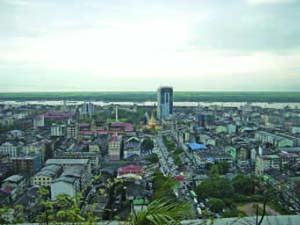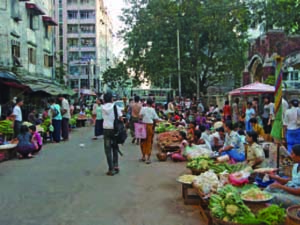Collaborators: KURAMOTO Ryosuke (University of Tokyo, Graduate School of Arts and Sciences)
NAKANISHI, Yoshihiro (Kyoto University, Center for Southeast Asian Studies)
ENDO, Tamaki (Saitama University, Faculty of Economics)
YAMADA, Kyota (Kyoto University, Graduate School of Asian and African Area Studies)
HINATA, Shinsuke (Kyoto University, Institute for Research in Humanities)
Term:2014-2015
Outline of Research:

The grid-shaped layout of Yangon. Sule Pagoda.at the centre.
This collaborative research project explores the possibilities of urbanography as a comprehensive area studies approach. Is it possible to construct a holistic image of a city with thick descriptions of particulars; the forms of buildings, landscapes of streets and wards, people’s living practices therein, and their historical changes? This project offers places and opportunities for young scholars engaged in various disciplines, who have worked on three cities on the Bay of Bengal region—Yangon, Bangkok and Colombo—, to discuss the possibilities of such a methodology as comprehensive and comparative areas studies.
Description:

Snapshot of everyday Yangon life. Market on the street.
At present, it is essential that area studies deepen its understandings of urban society and locate it in the larger context of the area/region. This collaborative research project explores the possibilities of an urbanography as comprehensive area studies. Here we use the word “urbanography” in the meaning of description which records in detail mutual interactions between urban space and human behavior across diverse dimensions within a city. It enables the construction of comprehensive and multilateral image of a city. This requires an inter-disciplinary collaborative approach by various experts, following a tradition of Southeast Asian Studies in Japan (especially CSEAS, Kyoto University).
Therefore, this collaborative research project offers opportunities to young scholars from various disciplines for discussion. Each participant comes from the disciplines of history, anthropology, political science, economic sociology, and civil engineering (architectural history). Through a survey and examination of existing literature of related disciplines, this group will explore general possibilities of urbanography. We will plan for a more specific collaborative research project for each city of Yangon, Bangkok and Colombo in which the participants have studied individually for long time.
These three are all main cities of Theravada Buddhist dominated countries in the Bay of Bengal region. Based on this, discussions between participants will provide a comparative perspective.
